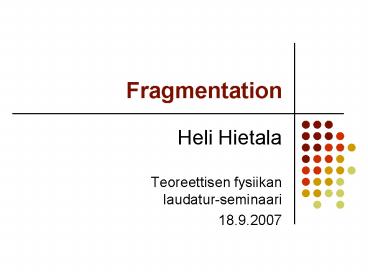Fragmentation - PowerPoint PPT Presentation
1 / 19
Title:
Fragmentation
Description:
planetesimals. industrial importance. building, mining, oil shale. physics ... ( 1982) while studying planetesimal collisions (rock impacts) V. t dev = 0.7 dev = 0.2 ... – PowerPoint PPT presentation
Number of Views:387
Avg rating:3.0/5.0
Title: Fragmentation
1
Fragmentation
- Heli Hietala
- Teoreettisen fysiikan laudatur-seminaari
- 18.9.2007
2
1 Introduction
- imagine you drop a plate or a vase onto the
kitchen floor - it stays intact
- it gets damaged
- it fragments into several pieces
- it shatters completely
3
1.1 Motivation
- any system can be fragmented when the imparted
energy is larger than the cohesive energy of the
system - a ubiquitous phenomenon in nature
- rocks, asteroids, planetesimals
- industrial importance
- building, mining,oil shale
- physics
- out-of-equilibrium process
- connections to turbulence, earthquakes
- liquid droplets, heavy atomic nuclei
- pharmaceuticals, chemicals, food
4
1.2 Basic concepts
- fragment size distribution ns
- complementary cumulative distribution
- size of the largest fragment, second largest,
etc. - moments of the size distribution
5
1.3 Scaling laws
- fragment size distribution is usually observed to
follow a power law - if so, the cumulative size distribution
- the observed t vary from 1 to around 2
6
1.4 Open questions
- fragmentation may depend on
- form, size and material of the object
- energy used in the breaking
- the way the object is broken
- etc.
- answers simulations
- easy determination of fragment sizes
- toying with parameters
Kun and Herrmann (1996)
7
2 Modelling the problem
- analytical models
- geometric fragmentation
- binary fission
- renormalization group techniques
- applying theoretical ideas
Grady and Kipp (1985)
8
2.1 Few words on percolation
(Stauffer and Aharony, Introduction to
Percolation Theory, (1994).)
- bond percolation
- two lattice cites connected with a bond that is
active with probability p - for p gt pc, a large cluster percolates through
the system - pc depends on the lattice type
- e.g. pc 0.5 for square lattice
- scaling near the critical point
- fragmentation of microscopic systems
- heavy nuclei and liquid droplets (Campi et al.
2000)
p 0.3
p 0.525
9
2.2 Phase transition approach
(following the ideas presented by F. Kun and H.J.
Herrmann (1999).)
- size of the largest fragment smax
- decreases as the impact velocity increases
- size of the second largest fragment smax2
- has a maximum
- same for m2
- implies divergence when N -gt 8
- by analogy to percolation theory critical
velocity Vc (?) - 2nd order phase transition?
10
2.3 Conceptual problems
- power law behaviour for all V gt Vc
- and not just near Vc
- alternatives to 2nd order phase transition
- some (known) out-of-equilibrium phase transition?
- self-organised criticality (SOC)?
- ????
11
2.4 Energy dependence
- Does the scaling exponent depend on the impact
energy? - simple analytical models
- one exponent, depends on the dimension of the
space - most simulations, few experiments
- exponent stays virtually constant
- most experiments and few simulations (Ching et
al. (1999), Moukarzel et al. (2007)) - exponent increases with increasing energy input
- But what is the exact energy dependence?
12
3 A simple numeric model
(N. Sator, S. Mechkov, F. Sausset and H. Hietala)
- meso-scale model
- a large disc of 1000 pieces
- launched into a wall with velocity V control
parameter - motion simulated with the Molecular Dynamics
method (MD) - interaction between the pieces
- fragments self-bound clusters
- irreversible fractures
13
3.1 Adding disorder
- sample the eij from a probability distribution
- vary the amount of disorder by varying the
standard deviation - for this work, we chose the gamma distribution
- possible to vary standard deviation independently
of the mean
14
3.2 Simulations
- Basic steps of the simulations (1)-(3)
- Statistics
- create 4-5 discs with the same parameter of
disorder - each disc is launched into the wall 500 times at
different angles
15
4 Results
Ordered system
Disordered system
16
4.1 Qualitative differences
- ordered system
- smooth fractures
- smooth fragments
- disordered system
- rugged fractures
- fragments with complex surface structure
Order t 1
t 20
Disorder t 1
t 20
17
4.2 Composite power law for all V gt Vc
and not just for
Standard deviation 0.7, impact velocity 2.0.
18
4.3 Scaling exponent
- scaling exponent in the large fragment region t
has a logarithmic dependence on the impact
velocity - the slope is independent of disorder
- the curve deviates from the line for smaller
velocity the more ordered the system is - experimentally observed by Matsui et al. (1982)
while studying planetesimal collisions (rock
impacts)
dev 0.7 dev 0.2 order
Matsui et al. (1982)
19
5 Summary and prospects
- key ideas
- fragmentation occurs everywhere in nature
- it is not known which parameters it depends on
- fragment size distribution is observed to follow
a power law -gt scaling - there might be a phase transition
- in this work
- observed a critical velocity Vc (?)
- fragment size distribution follows a composite
power law for V gt Vc - found a logarithmic dependence on the impact
velocity of the large fragment scaling exponent,
with a slope independent of disorder - future work
- consider other probability distributions -gt
universality? - analyze the accumulated data with the method of
maximum likelihood































